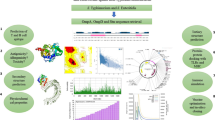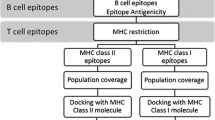Abstract
Salmonella is a gram-negative bacterium belonging to the Enterobacteriaceae family. One of the major known serotypes of this bacterium is Salmonella typhi. This pathogen is the main cause of diseases in humans and livestock. It is transmitted from animals to humans through the consumption of contaminated food. At the moment, one way to prevent this illness is using the live attenuated Ty21a vaccine. To eliminate the side effects of the vaccine and improve its safety, it is important to use epitope subunit vaccines. In this study, a wide range of accurate online servers have been used to predict the epitopes of OmpA, OmpC and OmpF antigens of Salmonella typhi. The T-cell (MHCI and MHCII) and B-cell epitopes share a degree of overlap between these tools. The highest scores were chosen for the study. Further analysis of their antigenicity and resistance to digestive compounds was performed by VaxiJen Servers and Protein Digest Servers. Eventually, the resultant epitopes that had desired antigenicity (≥ 1) and showed the highest resistance to digestive compounds were selected. Using these epitopes (MHCI, MHCII and B cell) two different structures (antigenic structure and digestion-resistant structure) were designed by rigid linkers. These structures were based on the highest antigenicity ranking of epitopes and the highest resistance of epitopes to digestive compounds, respectively. Given that this pathogen is primarily transmitted through contaminated foods, oral vaccines are essential in this regard. Therefore, these structures can be considered as suitable candidates for subunit vaccines.










Similar content being viewed by others
Data Availability
All materials and methods and obtained data from present work were reported in the manuscript.
References
Akiş N, Sayhan O, Karaçavuş A (2003) Immunogenicity and specificity of Salmonella typhimurium outer membrane antigens. J Cell Mol Biol 2
Als D et al (2018) Global trends in typhoidal salmonellosis: a systematic review. Am J Trop Med Hyg 99:10–19
Arai R, Ueda H, Kitayama A, Kamiya N, Nagamune T (2001) Design of the linkers which effectively separate domains of a bifunctional fusion protein. Protein Eng 14:529–532
Aurora R, Creamer TP, Srinivasan R, Rose GD (1997) Local interactions in protein folding: lessons from the α-helix. J Biol Chem 272:1413–1416
Baalaji NS, Mathew M, Krishnaswamy S (2006) Functional assay of Salmonella typhi OmpC using reconstituted large unilamellar vesicles: a general method for characterization of outer membrane proteins. Biochimie 88:1419–1424
Brandtzaeg P (2007) Induction of secretory immunity and memory at mucosal surfaces. Vaccine 25:5467–5484
Cardoso MO et al (2006) Antibiotic resistance in Salmonella enteritidis isolated from broiler carcasses. Braz J Microbiol 37:368–371
Chen X, Zaro JL, Shen W-C (2013) Fusion protein linkers: property, design and functionality. Adv Drug Deliv Rev 65:1357–1369
Contreras I, Munoz L, Toro CS, Mora GC (1995) Heterologous expression of Escherichia coli porin genes in Salmonella typhi Ty2: regulation by medium osmolarity, temperature and oxygen availability. FEMS Microbiol Lett 133:105–111
Forouharmehr A, Nassiry MR (2015) B and T-cell epitopes prediction of the P40 antigen for developing mycoplasma agalactiae vaccine using bioinformatic tools. Genet Millennium 13:3954–3961
Forouharmehr A, Nassiri M, Ghovvati S, Javadmanesh A (2017) Evaluation of different signal peptides for secretory production of recombinant bovine pancreatic ribonuclease A in gram negative bacterial system: an in silico study. Curr Proteomics 14:1–10. https://doi.org/10.2174/1570164614666170725144424
Gehring K, Nikaido H (1989) Existence and purification of porin heterotrimers of Escherichia coli K12 OmpC, OmpF, and PhoE proteins. J Biol Chem 264:2810–2815
Germanier R, Fiirer E (1975) Isolation and characterization of Gal E mutant Ty 21a of Salmonella typhi: a candidate strain for a live, oral typhoid vaccine. J Infect Dis 131:553–558
Hallstrom K, McCormick BA (2011) Salmonella interaction with and passage through the intestinal mucosa: through the lens of the organism. Front Microbiol 2:88
Hamid N, Jain S (2008) Characterization of an outer membrane protein of Salmonella enterica serovar Typhimurium that confers protection against typhoid. Clin Vaccine Immunol 15:1461–1471
Hong H, Szabo G, Tamm LK (2006) Electrostatic couplings in OmpA ion-channel gating suggest a mechanism for pore opening. Nat Chem Biol 2:627
Isibasi A, Ortiz V, Vargas M, Paniagua J, Gonzalez C, Moreno J, Kumate J (1988) Protection against Salmonella typhi infection in mice after immunization with outer membrane proteins isolated from Salmonella typhi 9, 12, d, Vi. Infect Immun 56:2953–2959
Jahandar MH, Forouharmehr A (2019) Optimization of human serum albumin periplasmic localization in Escherichia coli using in silico evaluation of different signal peptides. Int J Pept Res Ther 25:635–643
Jaydari A, Forouharmehr A, Nazifi N (2019) Determination of immunodominant scaffolds of Com1 and OmpH antigens of Coxiella burnetii. Microb Pathog 126:298–309
Klebba P, Benson S, Bala S, Abdullah T, Reid J, Singh S, Nikaido H (1990) Determinants of OmpF porin antigenicity and structure. J Biol Chem 265:6800–6810
Lertmemongkolchai G, Cai G, Hunter CA, Bancroft GJ (2001) Bystander activation of CD8+ T cells contributes to the rapid production of IFN-γ in response to bacterial pathogens. J Immunol 166:1097–1105
Li Y et al (2013) Bioinformatic prediction of epitopes in the Emy162 antigen of Echinococcus multilocularis. Exp Ther Med 6:335–340
Luirink J, Sinning I (2004) SRP-mediated protein targeting: structure and function revisited. Biochim et Biophys Acta (BBA)-Mol Cell Res 1694:17–35
Lundin BS, Johansson C, Svennerholm A-M (2002) Oral immunization with a Salmonella enterica serovar Typhi vaccine induces specific circulating mucosa-homing CD4+ and CD8+ T cells in humans. Infect Immunol 70:5622–5627
Macpherson AJ, Gatto D, Sainsbury E, Harriman GR, Hengartner H, Zinkernagel RM (2000) A primitive T cell-independent mechanism of intestinal mucosal IgA responses to commensal bacteria. Science 288:2222–2226
Morris AL, MacArthur MW, Hutchinson EG, Thornton JM (1992) Stereochemical quality of protein structure coordinates proteins: structure. Funct Bioinform 12:345–364
Moyle PM, Toth I (2013) Modern subunit vaccines: development, components, and research opportunities. ChemMedChem 8:360–376
Muthukkaruppan V, Nandakumar K, Palanivel V (1992) Monoclonal antibodies against Salmonella porins: generation and characterization. Immunol Lett 33:201–206
Nazifi N, Tahmoorespur M, Sekhavati MH, Haghparast A, Behroozikhah MA (2019) Assessment of signal peptides to optimize interleukin 2 (IL-2) folding and expression. Curr Proteomics 16:188–198
Newell DG et al (2010) Food-borne diseases—the challenges of 20 years ago still persist while new ones continue to emerge. Int J Food Microbiol 139:S3–S15
Nielsen H, Engelbrecht J, Brunak S, von Heijne G (1997) Identification of prokaryotic and eukaryotic signal peptides and prediction of their cleavage sites. Protein Eng 10:1–6
Pasetti MF, Simon JK, Sztein MB, Levine MM (2011) Immunology of gut mucosal vaccines. Immunol Rev 239:125–148
Pennington SH et al (2016) Oral typhoid vaccination with live-attenuated Salmonella typhi strain Ty21a generates Ty21a-responsive and heterologous influenza virus–responsive CD4+ and CD8+ T cells at the human intestinal mucosa. J Infect Dis 213:1809–1819
Ponomarenko JV, Van Regenmortel MH (2009) B cell epitope prediction. In: Gu J, Bourne PE (ed) Structural bioinformatics, 2nd edn. John Wiley, Hoboken, NJ, p 849–879
Puente J, Juárez D, Bobadilla M, Arias CF, Calva E (1995) The Salmonella ompC gene: structure and use as a carrier for heterologous sequences. Gene 156:1–9
Rogers S, Wells R, Rechsteiner M (1986) Amino acid sequences common to rapidly degraded proteins: the PEST hypothesis. Science 234:364–368. https://doi.org/10.1126/science.2876518
Soloff AC, Barratt-Boyes SM (2010) Enemy at the gates: dendritic cells and immunity to mucosal pathogens. Cell Res 20:872
Su L, Chiu C (2007) Salmonella: clinical importance and evolution of nomenclature. Chang Gung Med J 30:210
Walker D (2004) Oral mucosal immunology: an overview. Ann-Acad Med Singapore 33:27–30
Whiley H, Ross K (2015) Salmonella and eggs: from production to plate. Int J Environ Res Public Health 12:2543–2556
Zahraei Salehi T, Gharagozlou MJ, Shams N, Madadgar OM, Nayeri Fasaei B, Yahyaraeyat R (2012) Molecular characterization a Salmonella typhimurium isolate from Caspian pony. Iran J Biotechnol 10:49–54
Author information
Authors and Affiliations
Contributions
N. Shams introduced concept of this article. N. Nazifi and A.Forouharmehr contributed in preparing data analysis and epitope prediction. A.Forouharmehr Z.Shakarami included in development of the Epitope-based constructions, A. Jaydari and E. Rashidian interpreted the data. All team members contributed to the preparation of the manuscript. Authors read and approved the final manuscript.
Corresponding author
Ethics declarations
Conflict of interest
The authors declare there is no conflict of interest.
Ethical Approval and Informed Consent
The authors state that in this manuscript, all data were prepared in silico, and no data was collected from human or animal laboratory.
Additional information
Publisher's Note
Springer Nature remains neutral with regard to jurisdictional claims in published maps and institutional affiliations.
Rights and permissions
About this article
Cite this article
Shams, N., Shakarami Gandabeh, Z., Nazifi, N. et al. Computational Design of Different Epitope-Based Vaccines Against Salmonella typhi. Int J Pept Res Ther 26, 1527–1539 (2020). https://doi.org/10.1007/s10989-019-09959-4
Accepted:
Published:
Issue Date:
DOI: https://doi.org/10.1007/s10989-019-09959-4




